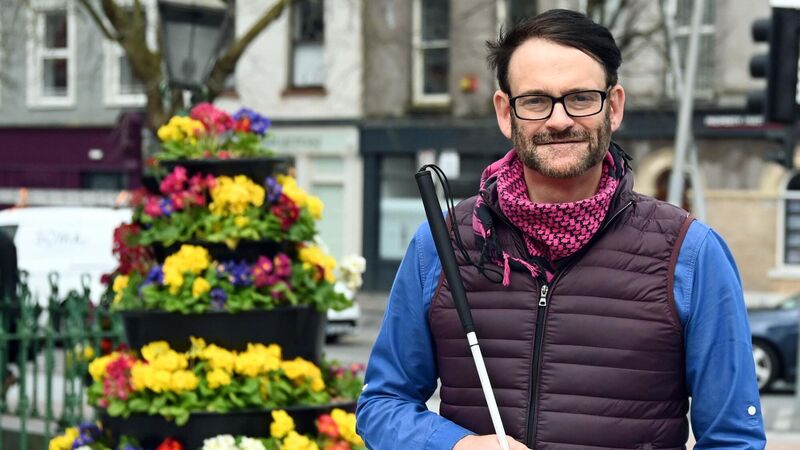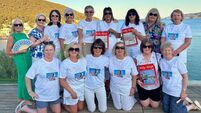How to give blind people in Cork a bit of backup

Robert Fourie, who is 95% blind and uses a cane to navigate Cork city.
CORK people are known for their great warmth and camaraderie. As a person who wanders these streets with a white cane, I have been fortunate to see the day-to-day interactions that happen.
While the Corkonians are as sound as a pound, there’s a thing or two that deserves a bit of attention: the willingness to lend a hand to those with sight issues.
From what I have seen, the notion to help out is grand, but now and again, not knowing how to go about it can make people hold back from offering support. But what really matters is the thought itself, fostering a sense of community spirit.
First and foremost, it’s important to get that people using long white canes might not be completely blind. In fact, most cane users have some sight left. This is the same for those who rely on service dogs, too.
If the person is likely to injure themselves or others because of a visual loss, they are entitled to use a cane or receive a service dog.
Long canes and service dogs are given to people who are registered as blind, but getting the hang of using a white cane properly takes a whole lot of training. And building up trust between a person with sight issues and a service dog needs even more training.
Long canes are usually white and shiny, so they’re easy to spot. They’re made from materials like carbon fibre or aluminium, so they’re light but strong. The cane sweeps to the right as a blind person puts down their left foot, so they can move forward safe and sound.

Being good with the cane can be different for different people; those with a bit more sight might seem more confident, while older folks who learn cane skills later in life might look a bit less sure and move more slowly.
Teaching kids about what a white cane means from a young age is important, so they know not to bump into people using canes. It does take me by surprise sometimes when grown-ups don’t know what a white cane stands for.
When a cane is folded up, it’s put on the ground and never on a table, for hygiene’s sake.
Generally, cane users know their way around, where they can cross safely, and how long their journeys might take. But every so often, unexpected things crop up. Like, roadworks might mean someone has to step onto the road, which can be risky. Or, broken traffic lights or pedestrian crossings can make things hard for people with sight issues.
This has gotten less common since the city council put in new electronic crossing systems (Well done Cork City Council!). These blue boxes make sounds and vibrations to let people know when it’s safe to cross with the green light. Even though there’s more of these pushbutton things across Cork now, they can still mess up sometimes.
When someone has to deal with something urgent, like busted traffic lights, it’s clear that offering help is a big deal. It shows that each of us chips in to keep everyone in our community safe and sound.
Knowing how to give a hand considerately is the key. None of us want to make someone feel awkward or force help on them. Here’s some simple tips to keep in mind when helping out someone with sight issues:
1. Offer Help, Don’t Assume: Walk over and ask if they would like some help, instead of just guessing. A nice way to ask could be, “Excuse me, would you be needing a hand?”
2. Wait for OK: If they say yes, wait for clear directions before helping out. Remember, everyone has their own way of accepting help.
Normally, they just need an elbow. Offer the elbow that suits them best if they’re holding a cane in one hand; let them take your elbow with their free hand.
3. Clear Talk: Give a short explanation of what’s around so the person can understand their surroundings. Details about things in the way or dangers are really useful.
4. Squeezing Through Tight Spots: When leading through narrow spots, stand a bit ahead and put your elbow behind you. This lets the person with sight issues walk behind you while they hold onto your elbow, so they can move comfy and safe. Remember to keep your elbow as relaxed as you can.
5. Never pull a blind person along as this will unbalance them; instead let them hook onto you.
Thinking of Service Dogs
Service dogs are mighty important pals for many people with sight issues. Be respectful and stick to these tips:
Do’s:
1. Ask First: Always get permission before you interact with a service dog.
2. Let Them Focus: Service dogs are working and need to concentrate. Don’t distract them.
3. Mind the Leash: If you have a dog, watch out for its movements so it doesn’t get tangled up with a cane or something else.
Don’ts:
1. Petting Without Asking: Don’t go petting or playing with a service dog unless you have been given the go-ahead.
2. Offering Treats: Service dogs have special diets. Giving them food can mess things up and disrupt their training.
In busy spots like Cork’s city centre, all of us need to keep an eye on our surroundings, especially when we are glued to our gadgets. More and more people are getting distracted by their smartphones, and that’s risky not just for them but for everyone else around. I have bumped into loads of people who were lost in their phones while walking, and it wasn’t much fun for either of us.
Recent numbers back this up, showing that there has been a big jump in people getting hurt or killed because of smartphone-related accidents. These numbers are a serious reminder that we need to stay alert, especially in busy city spots.
By lending a helping hand, the people of Cork can all do their bit to make the community more inclusive and kind. Even little acts of kindness can bridge gaps and make lives better.
So, next time you see someone with sight issues at a crosswalk or working their way through a crowded street, remember the impact of a simple offer: “Can I give you a hand?”







 App?
App?


